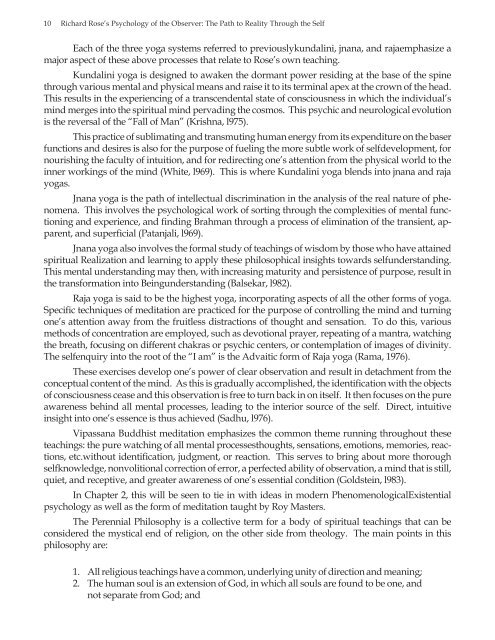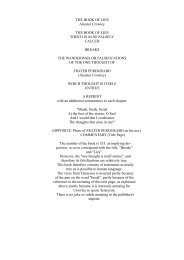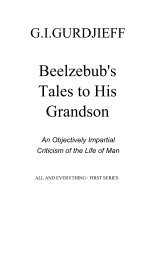Richard Rose’s Psychology of the Observer The Path to Reality Through the Self
John-Kent-Richard-Rose's-Psychology-of-Observer-Path-to-Reality-Thru-the-Self
John-Kent-Richard-Rose's-Psychology-of-Observer-Path-to-Reality-Thru-the-Self
Create successful ePaper yourself
Turn your PDF publications into a flip-book with our unique Google optimized e-Paper software.
10 <strong>Richard</strong> <strong>Rose’s</strong> <strong>Psychology</strong> <strong>of</strong> <strong>the</strong> <strong>Observer</strong>: <strong>The</strong> <strong>Path</strong> <strong>to</strong> <strong>Reality</strong> <strong>Through</strong> <strong>the</strong> <strong>Self</strong><br />
Each <strong>of</strong> <strong>the</strong> three yoga systems referred <strong>to</strong> previouslykundalini, jnana, and rajaemphasize a<br />
major aspect <strong>of</strong> <strong>the</strong>se above processes that relate <strong>to</strong> <strong>Rose’s</strong> own teaching.<br />
Kundalini yoga is designed <strong>to</strong> awaken <strong>the</strong> dormant power residing at <strong>the</strong> base <strong>of</strong> <strong>the</strong> spine<br />
through various mental and physical means and raise it <strong>to</strong> its terminal apex at <strong>the</strong> crown <strong>of</strong> <strong>the</strong> head.<br />
This results in <strong>the</strong> experiencing <strong>of</strong> a transcendental state <strong>of</strong> consciousness in which <strong>the</strong> individual’s<br />
mind merges in<strong>to</strong> <strong>the</strong> spiritual mind pervading <strong>the</strong> cosmos. This psychic and neurological evolution<br />
is <strong>the</strong> reversal <strong>of</strong> <strong>the</strong> “Fall <strong>of</strong> Man” (Krishna, l975).<br />
This practice <strong>of</strong> sublimating and transmuting human energy from its expenditure on <strong>the</strong> baser<br />
functions and desires is also for <strong>the</strong> purpose <strong>of</strong> fueling <strong>the</strong> more subtle work <strong>of</strong> selfdevelopment, for<br />
nourishing <strong>the</strong> faculty <strong>of</strong> intuition, and for redirecting one’s attention from <strong>the</strong> physical world <strong>to</strong> <strong>the</strong><br />
inner workings <strong>of</strong> <strong>the</strong> mind (White, l969). This is where Kundalini yoga blends in<strong>to</strong> jnana and raja<br />
yogas.<br />
Jnana yoga is <strong>the</strong> path <strong>of</strong> intellectual discrimination in <strong>the</strong> analysis <strong>of</strong> <strong>the</strong> real nature <strong>of</strong> phenomena.<br />
This involves <strong>the</strong> psychological work <strong>of</strong> sorting through <strong>the</strong> complexities <strong>of</strong> mental functioning<br />
and experience, and finding Brahman through a process <strong>of</strong> elimination <strong>of</strong> <strong>the</strong> transient, apparent,<br />
and superficial (Patanjali, l969).<br />
Jnana yoga also involves <strong>the</strong> formal study <strong>of</strong> teachings <strong>of</strong> wisdom by those who have attained<br />
spiritual Realization and learning <strong>to</strong> apply <strong>the</strong>se philosophical insights <strong>to</strong>wards selfunderstanding.<br />
This mental understanding may <strong>the</strong>n, with increasing maturity and persistence <strong>of</strong> purpose, result in<br />
<strong>the</strong> transformation in<strong>to</strong> Beingunderstanding (Balsekar, l982).<br />
Raja yoga is said <strong>to</strong> be <strong>the</strong> highest yoga, incorporating aspects <strong>of</strong> all <strong>the</strong> o<strong>the</strong>r forms <strong>of</strong> yoga.<br />
Specific techniques <strong>of</strong> meditation are practiced for <strong>the</strong> purpose <strong>of</strong> controlling <strong>the</strong> mind and turning<br />
one’s attention away from <strong>the</strong> fruitless distractions <strong>of</strong> thought and sensation. To do this, various<br />
methods <strong>of</strong> concentration are employed, such as devotional prayer, repeating <strong>of</strong> a mantra, watching<br />
<strong>the</strong> breath, focusing on different chakras or psychic centers, or contemplation <strong>of</strong> images <strong>of</strong> divinity.<br />
<strong>The</strong> selfenquiry in<strong>to</strong> <strong>the</strong> root <strong>of</strong> <strong>the</strong> “I am” is <strong>the</strong> Advaitic form <strong>of</strong> Raja yoga (Rama, 1976).<br />
<strong>The</strong>se exercises develop one’s power <strong>of</strong> clear observation and result in detachment from <strong>the</strong><br />
conceptual content <strong>of</strong> <strong>the</strong> mind. As this is gradually accomplished, <strong>the</strong> identification with <strong>the</strong> objects<br />
<strong>of</strong> consciousness cease and this observation is free <strong>to</strong> turn back in on itself. It <strong>the</strong>n focuses on <strong>the</strong> pure<br />
awareness behind all mental processes, leading <strong>to</strong> <strong>the</strong> interior source <strong>of</strong> <strong>the</strong> self. Direct, intuitive<br />
insight in<strong>to</strong> one’s essence is thus achieved (Sadhu, l976).<br />
Vipassana Buddhist meditation emphasizes <strong>the</strong> common <strong>the</strong>me running throughout <strong>the</strong>se<br />
teachings: <strong>the</strong> pure watching <strong>of</strong> all mental processesthoughts, sensations, emotions, memories, reactions,<br />
etc.without identification, judgment, or reaction. This serves <strong>to</strong> bring about more thorough<br />
selfknowledge, nonvolitional correction <strong>of</strong> error, a perfected ability <strong>of</strong> observation, a mind that is still,<br />
quiet, and receptive, and greater awareness <strong>of</strong> one’s essential condition (Goldstein, l983).<br />
In Chapter 2, this will be seen <strong>to</strong> tie in with ideas in modern PhenomenologicalExistential<br />
psychology as well as <strong>the</strong> form <strong>of</strong> meditation taught by Roy Masters.<br />
<strong>The</strong> Perennial Philosophy is a collective term for a body <strong>of</strong> spiritual teachings that can be<br />
considered <strong>the</strong> mystical end <strong>of</strong> religion, on <strong>the</strong> o<strong>the</strong>r side from <strong>the</strong>ology. <strong>The</strong> main points in this<br />
philosophy are:<br />
1. All religious teachings have a common, underlying unity <strong>of</strong> direction and meaning;<br />
2. <strong>The</strong> human soul is an extension <strong>of</strong> God, in which all souls are found <strong>to</strong> be one, and<br />
not separate from God; and




